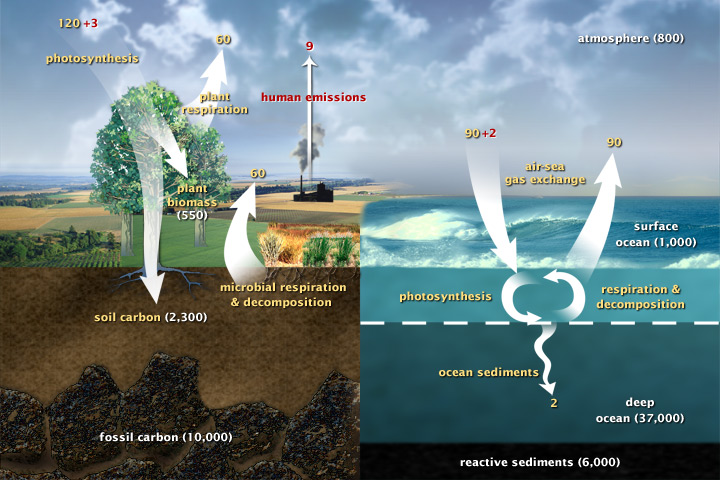Computational Guided Inquiry for Modeling Earth's Climate (Neshyba, 2023)¶
AdaptiveFlows¶
Overview¶
Figure 1 below shows some carbon fluxes in Earth's climate system. Values in yellow are the preindustrial values, with values in red indicating changes as of the year 2005.
 Figure 1. Carbon fluxes through Earth's climate system. Source: https://earthobservatory.nasa.gov/features/CarbonCycle.
Figure 1. Carbon fluxes through Earth's climate system. Source: https://earthobservatory.nasa.gov/features/CarbonCycle.
Of course, with the influx of anthropogenic carbon, the numbers are different today: the annual anthropogenic flux is much bigger than the 9 GtC this figure shows. But another difference has nothing (directly) to do with that change, but rather with the fact that these fluxes are also dependent on the concentrations of carbon in various parts of the system, and on the temperature of those parts of the system. The idea of this module is to take a step in increasing our ability to represent such nuances by considering one of the most fundamental of these flows, namely how the flux of carbon from the atmosphere to Earth's terrestrial surface depends on these two variables.
First-order kinetics¶
A key point about the flow of carbon out of the atmosphere is that it generally depends on how much carbon is in the atmosphere. This idea can be represented mathematically as
$$ F_{atm->land} = k_{al0} + k_{al1} [C_{atm}] \ \ \ \ (1) $$where $k_{al0}$ and $k_{al1}$ are what we call a rate constants, and $[C_{atm}]$ is the reservoir amount (or concentration) of carbon in the air, e.g., https://worldoceanreview.com/en/wor-1/ocean-chemistry/co2-reservoir/. Equation (1) represents what is called a 1st-order kinetic approach to climate modeling; other names for it include box modeling and stock-and-flow modeling (see, e.g., https://publish.illinois.edu/olaogunbayo/2015/11/17/2-box-models-and-climate/).
It's worth noting something about the $k_{al1} [C_{atm}]$ term in Eq. 1. It embodies the idea of $CO_2$ fertilization. How? All else equal, as more $CO_2$ is added to the atmosphere, $[C_{atm}]$ goes up, and therefore the flux of carbon from the atmosphere to the land, $F_{atm->land}$, also goes up. So $CO_2$ fertilization is built into our model already!
Adaptive first-order kinetics¶
As alluded to above, a problem one encounters with 1st-order kinetics in the context of climate change is that the "rules of the game" can be expected to be different in a future climate in which the temperature is higher. You can imagine that as Earth's temperature approaches some threshold value, processes like burning, drought, and beetle infestation could impair the ability of Earth's surface to sequester carbon (see, e.g., https://news.stanford.edu/2017/12/11/decades-increased-burning-depletes-soil-carbon/). This is an instance of a more general idea you are familiar with, namely climate feedbacks.
One way of incorporating this feedback would be to modify Eq. (1) to include an additional factor, $\sigma_{floor}$:
$$ F_{atm->land} = k_{al0} + \sigma_{floor} k_{al1} [C_{atm}] \ \ \ \ (2) $$We envision $\sigma_{floor}(T)$ to be a step function that embodies the fact that, in a warmer climate, the ability of Earth's surface to capture carbon will be reduced to some new, smaller value. In other words, at low temperatures, $\sigma_{floor}=1$, and we have the "usual", pre-industrial kind of photosynthetic behavior. But , but above some threshold temperature, $\sigma_{floor}$ drops to a new value, smaller than 1, representing an impairment of photosynthetic capture of atmospheric $CO_2$.
Sigmoidal algorithms¶
You'll probably say at this point, don't we already have a step function, $\sigma_{down}(t)$? And the answer is Yes! But we are going to use them differently: whereas $\sigma_{down}(t)$ was used to describe a time-dependent step-down, $\sigma_{floor}(T)$ will be used to describe a temperature-dependent step-down. Therefore $\sigma_{floor}(T)$ will need to be equipped with a temperature threshold defining the temperature at which we think the change will kick in, and another parameter that specifies the temperature range over which this kicking-in will take place. Here, we'll call these values $T^*$ and $\Delta T_{trans}$, respectively.
There is one significant algorithmic difference between $\sigma_{down}(t)$ and $\sigma_{floor}(T)$, however. Whereas $\sigma_{down}(t)$ steps down to zero at large values of $t$, $\sigma_{floor}(T)$ will need a floor at large values of $T$, to represent the fact that Earth's ability to capture carbon will drop to some new, presumably smaller value, but not all the way to zero (we hope), in a hotter climate. So that means $\sigma_{floor}(T)$ will need a third parameter, namely, the value of that floor.
A caveat¶
Implicit in the foregoing is the assumption that $\sigma_{floor}$ will drop a little in a warmer world. We should note that there is not universal consensus on this, however. Some have argued that whatever replaces forests could sequester more atmospheric carbon! (See https://climatechange.ucdavis.edu/news/grasslands-more-reliable-carbon-sink-than-trees/). Nevertheless, it is commonplace to treat assumptions like this assumption as contingently valid, for the purpose of exploring what its consequences might be.
Learning Goals¶
- I can describe the physical ideas behind the mathematics of first-order kinetics, including the meaning behind all the terms in Eq. (2).
- I can describe, and implement code for, adaptive first-order kinetics, in terms of a step function.